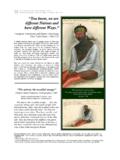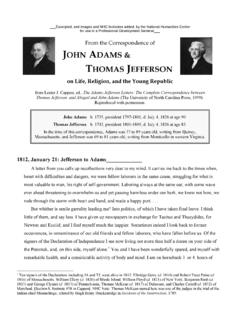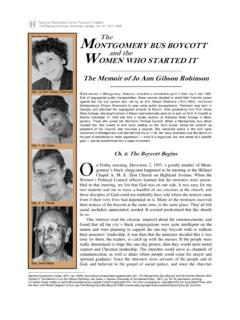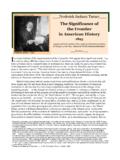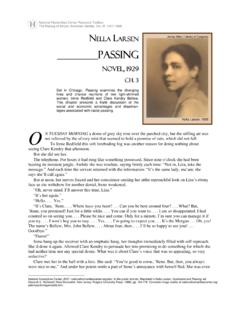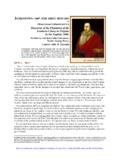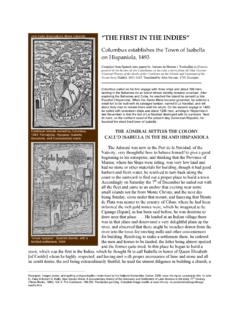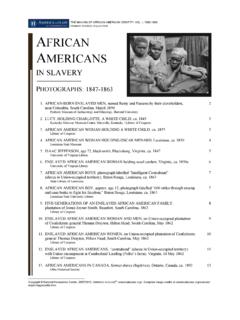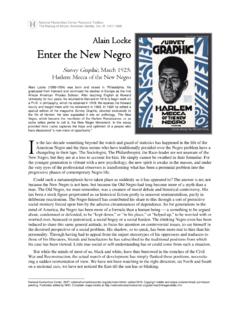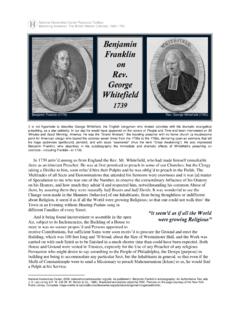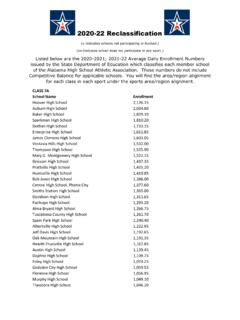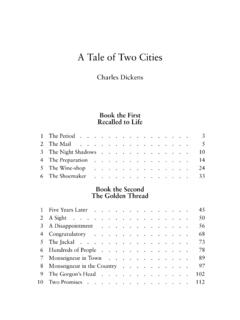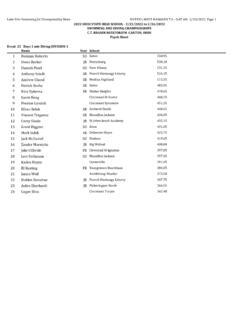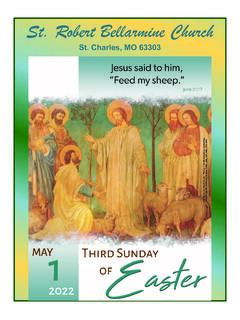Transcription of ETTER OF HRISTOPHER OLUMBUS - National Humanities Center
1 National Humanities Center Resource Toolbox American Beginnings: The European Presence in North America, 1492-1690 the glorious success that our Lord has given me in my voyage * LETTER OF CHRISTOPHER COLUMBUS ON HIS FIRST VOYAGE TO AMERICA, 1492 Written in 1493, to the Treasurer of Aragon, Luis de St. Angel, who had provided Castile Ta no Indians his settlement La Navidad on the north coast of present-day Haiti SIR: S I know you will be rejoiced at the glorious success that our Lord has given me in my voyage, I write this to tell you how in thirty-three days I sailed to the Indies with the fleet that the illustrious King and Queen, our Sovereigns, gave me, where I discovered a great many islands inhabited by numberless people; and of all I have taken possession for their Highnesses by proclamation and display of the Royal Standard [Spanish flag] without opposition.
2 To the first island I discovered I gave the name of San Salvador in commemoration of His Divine Majesty, who has wonderfully granted all this. The Indians call it The second I named the Island of Santa Maria de Concepcion; the third, Fernandina; the fourth, Isabella; the fifth, Juana; and thus to each one I gave a new When I came to Juana, I followed the coast of that isle toward the west and found it so extensive that I thought it might be the mainland, the province of Cathay [China]; and as I found no towns nor villages on the seacoast, except a few small settlements, where it was impossible to speak to the people because they fled at once, I continued the said route, thinking I could not fail to see some great cities or towns; and finding at the end of many leagues that nothing new appeared and that the coast led northward, contrary to my wish, because the winter had already set in, I decided to make for the south, and as the wind also was against my proceeding, I determined not to wait there longer and turned back to a certain harbor whence I sent two men to find out whether there was any king or large city.
3 They explored for three days and found countless small communities and people, without number, but with no kind of government, so they returned. * National Humanities Center , 2006: charles W. Eliot, ed., American Historical Documents, 1000-1904, Harvard Classics, vol. 43 (New York: Collier, 1910). Some paragraphing added by NHC. Image on this page: detail from Diego Guti rrez, Americae sive qvartae orbis, map of the western hemisphere, 1562; courtesy of the Library of Congress. Complete image credits at 1 Also Guanahani. Columbus made landfall in the Bahamas or the Turks & Caicos, north of the island of Hispaniola (present-day Haiti and the Dominican Republic). While there is insufficient evidence to specify the island, contenders include San Salvador (formerly Watling Island) and Samana Cay in the Bahamas.
4 2 Island of Santa Maria de Concepcion: Rum Cay, Bahamas. Fernandina: Long Island, Bahamas. Isabella: Crooked Island, Bahamas. Juana: Cuba. A Library of Congress P. Forlani, Vniversale descrittione di tvtta la terra conoscivta fin qvi, world map, Venice: 1565, detail with approximate route of Columbus s first voyage added National Humanities Center Columbus s letter on his first voyage to America, February 1493 2 I heard from other Indians I had already taken that this land was an island, and thus followed the eastern coast for one hundred and seven leagues3 until I came to the end of it. From that point I saw another isle to the eastward, at eighteen leagues distance, to which I gave the name of I went thither and followed its northern coast to the east, as I had done in Juana, one hundred and seventy-eight leagues eastward, as in Juana.
5 This island, like all the others, is most extensive. It has many ports along the seacoast excelling any in Christendom and many fine, large, flowing rivers. The land there is elevated, with many mountains and peaks incomparably higher than in the centre isle. They are most beautiful, of a thousand varied forms, accessible, and full of trees of endless varieties, so high that they seem to touch the sky, and I have been told that they never lose their foliage. I saw them as green and lovely as trees are in Spain in the month of May. Some of them were covered with blossoms, some with fruit, and some in other conditions, according to their kind. The nightingale and other small birds of a thousand kinds were singing in the month of November when I was there. There were palm trees of six or eight varieties, the graceful peculiarities of each one of them being worthy of admiration as are the other trees, fruits and grasses.
6 There are wonderful pine woods, and very extensive ranges of meadow land. There is honey, and there are many kinds of birds, and a great variety of fruits. Inland there are numerous mines of metals and innumerable people. Hispaniola is a marvel. Its hills and mountains, fine plains and open country, are rich and fertile for planting and for pasturage, and for building towns and villages. The seaports there are incredibly fine, as also the magnificent rivers, most of which bear gold. The trees, fruits and grasses differ widely from those in Juana. There are many spices and vast mines of gold and other metals in this island. They have no iron, nor steel, nor weapons, nor are they fit for them, because although they are well-made men of commanding stature, they appear extraordinarily timid.
7 The only arms [weapons] they have are sticks of cane, cut when in seed with a sharpened stick at the end, and they are afraid to use these. Often I have sent two or three men ashore to some town to converse with them, and the natives came out in great numbers, and as soon as they saw our men arrive, fled without a moment s delay although I protected them from all injury. At every point where I landed and succeeded in talking to them, I gave them some of everything I had cloth and many other things without receiving anything in return, but they are a hopelessly timid people. It is true that since they have gained more confidence and are losing this fear, they are so unsuspicious and so generous with what they possess, that no one who had not seen it would believe it.
8 They never refuse anything that is asked for. They even offer it themselves, and show so much love that they would give their very hearts. Whether it be anything of great or small value, with any trifle of 3 The Spanish league was about miles. 4 C de SPANOLA on the Guti rrez map above (present-day Haiti and the Dominican Republic). Hispaniola is a marvel. National Humanities Center Columbus s letter on his first voyage to America, February 1493 3 Library of Congress Ta no amulet of a crouching figure, Puerto Rico (?), marble, AD 1000 1500 whatever kind, they are satisfied. I forbade worthless things being given to them, such as bits of broken bowls, pieces of glass, and old straps, although they were as much pleased to get them as if they were the finest jewels in the world.
9 One sailor was found to have got for a leathern strap, gold of the weight of two and a half castellanos, and others for even more worthless things much more; while for a new blancas they would give all they had, were it two or three castellanos of pure gold or an arroba or two of spun Even bits of the broken hoops of wine casks they accepted, and gave in return what they had, like fools, and it seemed wrong to me. I forbade it, and gave a thousand good and pretty things that I had to win their love and to induce them to become Christians, and to love and serve their Highnesses and the whole Castilian nation, and help to get for us things they have in abundance, which are necessary to us. They have no religion nor idolatry, except that they all believe power and goodness to be in heaven.
10 They firmly believed that I, with my ships and men, came from heaven, and with this idea I have been received everywhere, since they lost fear of me. They are, however, far from being ignorant. They are most ingenious men, and navigate these seas in a wonderful way and describe everything well, but they never before saw people wearing clothes, nor vessels like ours. Directly I reached the Indies in the first isle I discovered, I took by force some of the natives, that from them we might gain some information of what there was in these parts; and so it was that we immediately understood each other, either by words or signs. They are still with me and still believe that I come from heaven. They were the first to declare this wherever I went, and the others ran from house to house, and to the towns around, crying out, Come!
